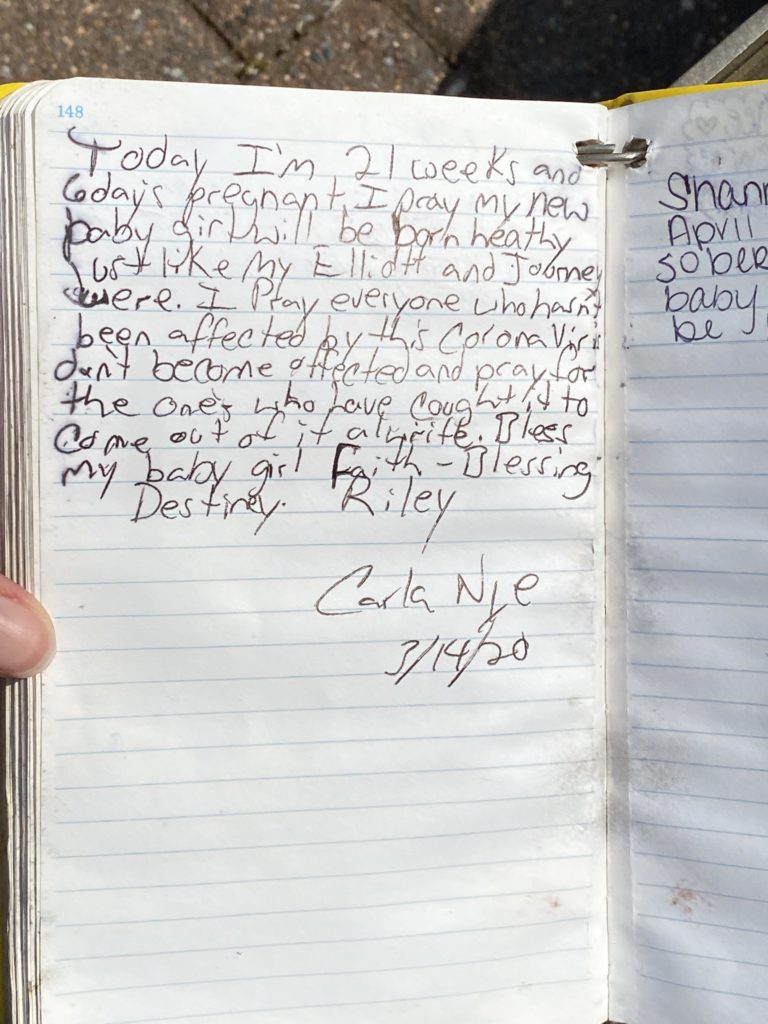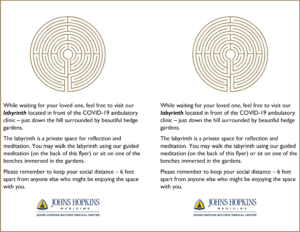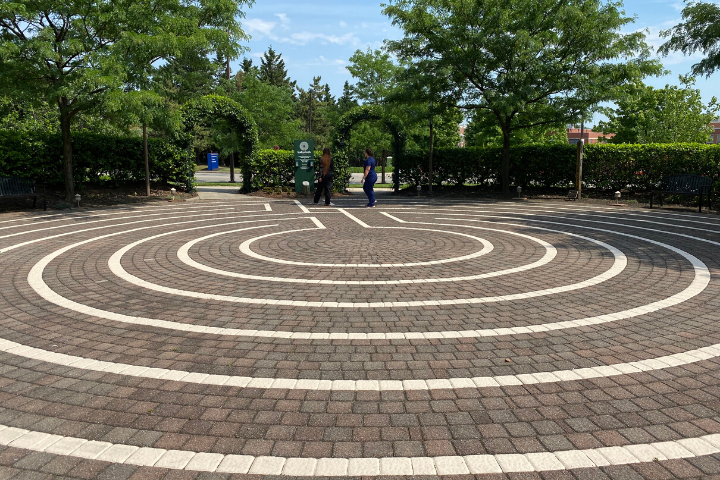Labyrinth Flyer 2020 Pictured above, two hospital staff taking a break by walking the Labyrinth. June 2020
Among the most heartbreaking stories that have emerged from this pandemic is that of patients convalescing alone — dying alone — in hospitals; of families not being permitted beyond waiting rooms. The stress and worry of waiting for word on a loved one’s condition is something many of us can relate to — but this new isolation adds another layer of suffering and stress, which can have severe and long-term health impacts on the family members themselves.

Some hospitals though are thinking of ways they can help ease the burden for families: at Johns Hopkins Bayview Medical Center, which has been treating patients with COVID-19 since the beginning of the pandemic, family members are being urged to spend time in the hospital’s Sacred Place, which is located on Mason Lord Drive, adjacent to the Francis Scott Key Pavilion entrance, and includes a labyrinth.
Andrea Fitz, a program coordinator in the Department of Spiritual Care and Chaplaincy, serves as a co-Firesoul of the Johns Hopkins Bayview labyrinth. It was during a recent conversation with Andrea that Nature Sacred’s Chief Programs Officer, Erin Robertson, learned of how the Medical Center is leaning on the garden during these particularly challenging times.
“It has been such a blessing to have the labyrinth located so closely to our COVID-19 ambulatory clinic,” said Fitz. “We’ve been able to direct families who are unable to accompany their loved ones in the clinic to the labyrinth – a quiet, healing, meditative space. At a time when anxiety is high, the labyrinth has been a tremendous resource for patients, families and employees.”
Here, at the Johns Hopkins Bayview labyrinth, visitors can remain close to their loved ones, while at the same time doing something to mitigate and manage their own stress, the ripple effects of which can last long after their hospital vigils have passed. While nature is well-documented for its benefits in a therapeutic setting, the labyrinth itself offers its own benefits to those who walk it.
Strolling through a labyrinth can help you feel the relaxation response, which is the opposite of the stress “fight or flight” state, Dr. Herbert Benson, founder of the Benson-Henry Institute for Mind Body Medicine at Massachusetts General Hospital, has been quoted as saying.
In a WebMD article on the health benefits of labyrinths, Benson said: “More than 30 years of research shows that the relaxation response brings slower breathing, a slower heart rate, and lower blood pressure, among other things.”
Aside from the evidence that exists in previous research that’s been conducted, proof of the impact of the Johns Hopkins Bayview labyrinth on visitors is also being documented in the journal entries left by those who’ve visited the space in recent weeks. The journals are tucked in pockets beneath the seats of benches placed in the space.
Critical illness and death in an ICU can result in a significant burden of stress and anxiety among family members and may result in both short- and long-term psychological symptoms associated with disorders, such as complicated grief, posttraumatic stress disorder (PTSD), and depression.
Predictors of Symptoms of Posttraumatic Stress and Depression in Family Members After Patient Death in the ICU
Paula Teague, Senior Director of Spiritual Care and Chaplaincy for the Johns Hopkins Health System, and the Sacred Place’s original Firesoul, has long been devoted to helping people cope with trauma—to find peace, hope and comfort amidst stress and suffering. She has been working closely with families, and even employees, to help introduce them to the labyrinth.
“It has been important for us to not only direct families and employees to the labyrinth space but to also provide them with a guided walk. Sometimes people are not familiar enough with the labyrinth to understand the profound settling quality of a labyrinth walk,” Teague said.
“The guided walk was developed especially for this time as we struggle with COVID-19. We have been providing copies of the guided walk at the outpatient COVID-19 clinic for families. We want to maximize the experience at the labyrinth for all who decide to use the Sacred Place.”
For the past several years, therapeutic gardens — some of which have labyrinths, and some that don’t — increasingly have been used by hospitals as a means both to augment patient care and to provide an environment that helps reduce the health impact family members are at risk of experiencing due to the stress of having a relative hospitalized.
While good data on how many hospitals have therapeutic gardens of any kind on their premises is hard to come by, Teresia Hazen, a horticultural therapist and Firesoul of another hospital-based Sacred Place; this one at Legacy Emanuel Medical Center in Portland, said the number is growing.
This is work Nature Sacred continues to support. While COVID-19 has created a scenario where hospital gardens presently have an expanded role to play, due to the limitations placed on patient visits, the fact is — the benefits of nature as a therapeutic and as a means to help people cope are timeless.

We encourage hospitals that are interested in learning about how to establish a Sacred Place on their grounds to reach out to us. We are happy to connect you with our Firesouls and to share resources and data to assist with developing strong proposals for garnering funding support.

